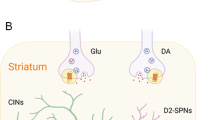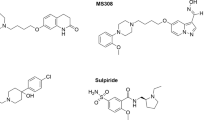Abstract
Signalling through dopamine D2 receptors governs physiological functions related to locomotion, hormone production and drug abuse1,2,3,4,5,6,7. D2 receptors are also known targets of antipsychotic drugs that are used to treat neuropsychiatric disorders such as schizophrenia8. By a mechanism of alternative splicing, the D2 receptor gene encodes two molecularly distinct isoforms9, D2S and D2L, previously thought to have the same function. Here we show that these receptors have distinct functions in vivo; D2L acts mainly at postsynaptic sites and D2S serves presynaptic autoreceptor functions. The cataleptic effects of the widely used antipsychotic haloperidol1 are absent in D2L-deficient mice. This suggests that D2L is targeted by haloperidol, with implications for treatment of neuropsychiatric disorders. The absence of D2L reveals that D2S inhibits D1 receptor-mediated functions, uncovering a circuit of signalling interference between dopamine receptors.
This is a preview of subscription content, access via your institution
Access options
Subscribe to this journal
Receive 51 print issues and online access
$199.00 per year
only $3.90 per issue
Buy this article
- Purchase on Springer Link
- Instant access to full article PDF
Prices may be subject to local taxes which are calculated during checkout



Similar content being viewed by others
References
Jackson, D. J. & Westlind-Danielsson, A. Dopamine receptors: Molecular biology, biochemistry and behavioural aspects. Pharmacol. Ther. 64, 291–369 ( 1994).
Baik, J. H. et al. Parkinsonian-like locomotor impairment in mice lacking dopamine D2 receptors. Nature 377, 424– 428 (1995).
Kelly, M. A. et al. Locomotor activity in D2 dopamine receptor-deficient mice is determined by gene dosage, genetic background, and developmental adaptations. J. Neurosci. 18, 3470– 3479 (1998).
Jung, M. et al. Potentiation of the D2 mutant motor phenotype in mice lacking dopamine D2 and D3 receptors. Neuroscience 91, 911 –924 (1999).
Maldonado, R. et al. Absence of opiate rewarding effects in mice lacking dopamine D2 receptors. Nature 388, 586– 589 (1997).
Saiardi, A., Bozzi, Y., Baik, J. H. & Borrelli, E. Antiproliferative role of dopamine: loss of D2 receptors causes hormonal dysfunction and pituitary hyperplasia. Neuron 19, 115– 126 (1997).
Kelly, M. A. et al. Pituitary lactotroph hyperplasia and chronic hyperprolactinemia in dopamine D2 receptor-deficient mice. Neuron 19, 103–113 (1997).
Egan, M. F. & Weinberger, D. R. Neurobiology of schizophrenia. Curr. Opin. Neurobiol. 7, 701– 707 (1997).
Picetti, R. et al. Dopamine D2 receptors in signal transduction and behavior. Crit. Rev. Neurobiol. 11, 121– 142 (1997).
Mercuri, N. B. et al. Loss of autoreceptor function in dopaminergic neurons from dopamine D2 receptor deficient mice. Neuroscience 79 , 323–327 (1997).
Calabresi, P. et al. Abnormal synaptic plasticity in the striatum of mice lacking dopamine D2 receptors. J. Neurosci. 17, 4536–4544 (1997).
L’Hirondel, M. et al. Lack of autoreceptor-mediated inhibitory control of dopamine release in striatal synaptosomes of D2 receptor-deficient mice. Brain Res. 792, 253–262 (1998).
Montmayeur, J. P., Guiramand, J. & Borrelli, E. Preferential coupling between dopamine D2 receptors and G-proteins. Mol. Endocrinol. 7, 161– 170 (1993).
Guiramand, J., Montmayeur, J. P., Ceraline, J., Bhatia, M. & Borrelli, E. Alternative splicing of the dopamine D2 receptor directs specificity of coupling to G-proteins. J. Biol. Chem. 270, 7354–7358 ( 1995).
Crenshaw, E. B. III, Russo, A. F., Swanson, L. W. & Rosenfeld, M. G. Neuron specific alternative RNA processing in transgenic mice expressing a metallothionein-calcitonin fusion gene. Cell 49, 389–398 ( 1987).
Eilam, D. & Szechtman, H. Biphasic effect of D2 agonist quinpirole on locomotion and movements. Eur. J. Pharmacol. 161, 151–157 (1989).
Starke, K., Gothert, M. & Kilbinger, H. Modulation of neurotrasmitter release by presynaptic autoreceptors. Physiol. Rev. 69, 864– 989 (1989).
Boulay, D. et al. Haloperidol-induced catalepsy is absent in dopamine D2, but maintained in dopamine D3 receptor knock-out mice. Eur. J. Pharmacol. 391, 63–73 ( 2000).
Protais, P., Bonnet, J. & Constantin, J. Pharmacological characterization of the receptors involved in the apomorphine induced polyphasic modifications of locomotor activity in mice. Psychopharmacology 81, 126– 134 (1983).
Ruskin D. N., Rawji, S. S. & Walters, J. R. Effects of full D1 dopamine receptor agonists on firing rates in the globus pallidus and substantia nigra pars compacta in vivo: tests for D1 receptor selectivity and comparisons to the partial agonist SKF 38393. J. Pharmacol. Exp. Ther. 286, 272–281 (1998).
Nisenbaum, E. S., Mermelstein, P. G., Wilson, C. J. & Surmeier, D. J. Selective blockade of a slowly inactivating potassium current in striatal neurons by (±) 6-chloro-APB hydrobromide (SKF82958). Synapse 29, 213–224 ( 1998).
Xu, F. et al. Mice lacking the norepinephrine transporter are supersensitive to psychostimulants. Nature Neurosci. 3, 465 –471 (2000).
Boulay, D., Depoortere, R., Perrault, G., Borrelli, E. & Sanger, D. J. Dopamine D2 receptor knock-out mice are insensitive to the hypolocomotor and hypothermic effects of dopamine D2/D3 receptor agonists. Neuropharmacology 38, 1389–1396 (1999).
Waddington, J. L., Daly, S. A. In D1:D2 dopamine receptor interactions (ed. Waddington, J.) 52–74 (Academic, London, 1993).
Rubinstein, M., Gershanik, O. & Stefano, F. J. E. Postsynaptic bimodal effect of sulpiride on locomotor activity induced by pergolide in cathecholamine-depleted mice. Naunyn-Schmiedeberg's Arch. Pharmacol. 337, 115– 117 (1988).
Stoof, J. C. & Kebabian, J. W. Opposing roles for D-1 and D-2 dopamine receptors in efflux of cyclic AMP from rat neo-striatum. Nature 294, 366–368 ( 1981).
Surmeier, D. J., Song, W. J. & Yan, Z. Coordinated expression of dopamine receptors in neostriatal medium spiny neurons. J. Neurosci. 16, 6579 –6591 (1996).
Aizman, O. et al. Anatomical and physiological evidence for D1 and D2 dopamine receptor colocalization in neostriatal neurons. Nature Neurosci. 3, 226–230 ( 2000).
Kahn, Z. U. et al. Prominence of the dopamine D2 short isoform in dopaminergic pathways. Proc. Natl Acad. Sci. USA 95, 7731–7736 (1998).
Rougé-Pont, F., Marinelli, M., LeMoal, M., Simon, H. & Piazza, P. V. Stress induced sensitization and glucocorticoids II: sensitization of the increase in extracellular dopamine induced by cocaine depends on stress-induced corticosterone secretion. J. Neurosci. 15, 7189–7195 (1995).
Acknowledgements
We thank A. Saiardi for help in the initial phase of this work and D. Vallone, C. Mathis, M. Omori and J. Clifford for useful discussions. We are grateful to V. Heidt, Muriel Petit and Nelly Charrier for technical help. We thank A. Giovanni for the generous gift of SKF 81297. This work was supported by grants from INSERM, CNRS, HUS, MILDT and ARC (to E.B.), INSERM and Université de Bordeaux II (to P.V.P.) and from the Mariano Scippacercola Foundation and FRM fellowships to A.U.
Author information
Authors and Affiliations
Corresponding author
Rights and permissions
About this article
Cite this article
Usiello, A., Baik, JH., Rougé-Pont, F. et al. Distinct functions of the two isoforms of dopamine D2 receptors. Nature 408, 199–203 (2000). https://doi.org/10.1038/35041572
Received:
Accepted:
Issue Date:
DOI: https://doi.org/10.1038/35041572
This article is cited by
-
The human neuropsychiatric risk gene Drd2 is necessary for social functioning across evolutionary distant species
Molecular Psychiatry (2023)
-
The Roles of hnRNP Family in the Brain and Brain-Related Disorders
Molecular Neurobiology (2023)
-
An alternative splicing hypothesis for neuropathology of schizophrenia: evidence from studies on historical candidate genes and multi-omics data
Molecular Psychiatry (2022)
-
Dopamine Receptor Expression and the Pathogenesis of Attention-Deficit Hyperactivity Disorder: a Scoping Review of the Literature
Current Developmental Disorders Reports (2022)
-
Functionally selective activation of the dopamine receptor D2 is mirrored by the protein expression profiles
Scientific Reports (2021)
Comments
By submitting a comment you agree to abide by our Terms and Community Guidelines. If you find something abusive or that does not comply with our terms or guidelines please flag it as inappropriate.



